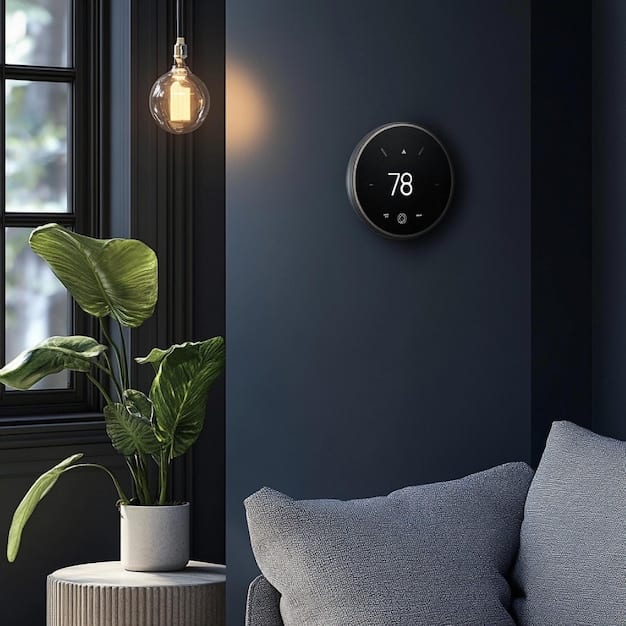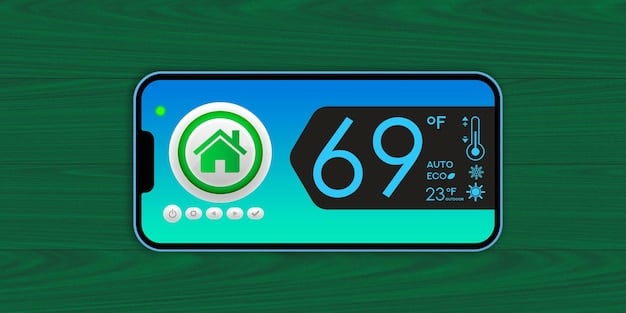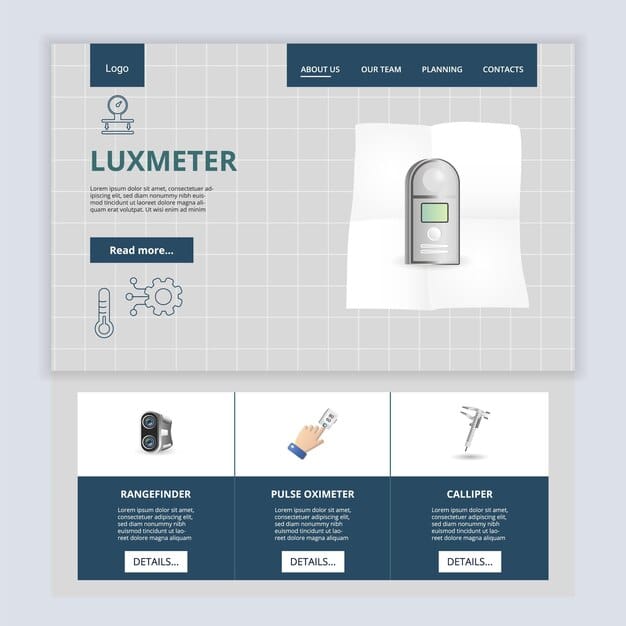Save Money on Energy Bills: Install a Smart Thermostat

Save money on energy bills by installing a smart thermostat and reduce heating costs by 10% or more, enhancing home comfort and efficiency.
Looking for a smart way to cut down on your energy expenses? Installing a smart thermostat and reduce heating costs by 10% is a great way to start.
Understanding Smart Thermostats and Energy Savings
Smart thermostats are becoming increasingly popular for homeowners looking to manage their energy consumption more effectively. These devices offer numerous benefits, from remote control to intelligent learning capabilities, all aimed at reducing your energy bills.
But how exactly do they work, and why should you consider investing in one? Let’s dive into the basics.
What is a Smart Thermostat?
A smart thermostat is a Wi-Fi-enabled device that lets you control your home’s heating and cooling system from anywhere using a smartphone, tablet, or computer. Unlike traditional thermostats, smart thermostats offer advanced features such as:
- Remote Access: Adjust the temperature settings from anywhere.
- Learning Capabilities: Learns your heating and cooling preferences and automatically adjusts the temperature.
- Energy Monitoring: Provides insights into your energy usage.
How They Save Energy
Smart thermostats save energy in several ways. By learning your schedule and preferences, they can automatically adjust the temperature when you’re away or asleep. This eliminates wasted energy from heating or cooling an empty home.

Additionally, many smart thermostats offer features like geofencing, which uses your smartphone’s location to determine when you’re coming home and adjusts the temperature accordingly. This ensures your home is comfortable when you arrive without wasting energy while you’re away.
In summary, smart thermostats offer a convenient and effective way to reduce your energy consumption and lower your utility bills. These devices provide advanced features and capabilities that allow you to manage your home’s temperature with precision and ease.
Benefits of Installing a Smart Thermostat
Beyond just saving energy, installing a smart thermostat comes with a host of other benefits that can improve your home’s comfort and efficiency. Here are some of the key advantages:
Investing in a smart thermostat isn’t just about saving money; it’s about enhancing your lifestyle and making your home more comfortable and convenient.
Enhanced Comfort and Convenience
With a smart thermostat, you can ensure your home is always at the perfect temperature. No more coming home to a cold house in the winter or a stuffy one in the summer. You can easily adjust the temperature from anywhere, so your home is always comfortable when you arrive.
Additionally, smart thermostats offer features like scheduling and automation, which take the guesswork out of managing your home’s temperature. Set it and forget it, knowing your home will be comfortable without you having to constantly adjust the settings.
- Consistent Temperature: No more temperature fluctuations.
- Remote Adjustments: Adjust from anywhere using your smartphone.
- Automated Scheduling: Set it and forget it.
Increased Energy Efficiency
Smart thermostats are designed with energy efficiency in mind. By learning your habits and preferences, they can optimize your home’s heating and cooling system to minimize energy waste. This can lead to significant savings on your utility bills over time.
Furthermore, many smart thermostats provide detailed energy reports, allowing you to track your usage and identify areas where you can further reduce your energy consumption. This helps you make informed decisions about your energy habits.
In conclusion, installing a smart thermostat offers a range of benefits, from enhanced comfort and convenience to increased energy efficiency and cost savings. These devices are a smart investment for any homeowner looking to improve their home’s performance and reduce their environmental impact.
Choosing the Right Smart Thermostat
With so many smart thermostats on the market, choosing the right one for your home can be a daunting task. Each model offers different features and capabilities, so it’s important to consider your specific needs and preferences before making a purchase.
Here are some factors to consider when selecting a smart thermostat.
Compatibility
Before you buy a smart thermostat, make sure it’s compatible with your home’s heating and cooling system. Some thermostats are designed to work with specific types of systems, such as forced air, heat pumps, or radiant heating. Check the manufacturer’s specifications to ensure compatibility.
Features
Smart thermostats come with a variety of features, such as geofencing, learning capabilities, energy monitoring, and voice control. Consider which features are most important to you and choose a thermostat that offers them.
For example, if you want to be able to control your thermostat with your voice, look for a model that’s compatible with Amazon Alexa or Google Assistant.

Selecting the right smart thermostat involves careful consideration of your needs and preferences. By evaluating the compatibility, features, and smart home integration of different models, you can find the perfect thermostat to help you save energy and enhance your home’s comfort.
Installation Tips
Installing a smart thermostat is a relatively straightforward process that most homeowners can handle themselves. However, it’s important to follow the instructions carefully to avoid damaging your thermostat or your home’s heating and cooling system.
Here are some tips to help you install your smart thermostat successfully.
Safety First
Before you begin, turn off the power to your home’s heating and cooling system at the circuit breaker. This will prevent electrical shock during the installation process. Use a non-contact voltage tester to ensure the power is off before touching any wires.
Follow the Instructions
Read the manufacturer’s instructions carefully before you begin installing your smart thermostat. The instructions will provide detailed guidance on how to wire the thermostat correctly and configure it for your specific heating and cooling system.
A successful installation not only ensures the correct functioning of your smart thermostat but also optimizes its energy-saving capabilities.
- Turn Off Power: Always turn off the power before starting.
- Read Instructions: Follow the manufacturer’s guidelines.
- Label Wires: Label wires to avoid confusion.
Wiring Tips
Label the wires before disconnecting them from your old thermostat. This will help you connect them correctly to your new smart thermostat. If you’re unsure about the wiring, take a photo of the old thermostat’s wiring configuration before disconnecting anything.
If your home doesn’t have a C-wire (common wire), you may need to install one or use a C-wire adapter. Some smart thermostats require a C-wire to function properly, as it provides a constant source of power.
By following these installation tips, you can ensure a smooth and successful installation of your smart thermostat. Proper installation is essential for maximizing the benefits of your smart thermostat and reducing your energy bills.
Maximizing Energy Savings
Installing a smart thermostat is just the first step in saving money on your energy bills. To maximize your savings, you need to use your thermostat effectively and adopt other energy-saving habits.
Here are some tips to help you get the most out of your smart thermostat and reduce your energy consumption.
Set a Schedule
Use your smart thermostat’s scheduling feature to create a schedule that matches your daily routine. Set the temperature to be lower when you’re away or asleep and higher when you’re home and awake. This will prevent you from wasting energy heating or cooling an empty home.
Consider adjusting your schedule seasonally to account for changes in weather patterns and daylight hours.
- Adjust Seasonally: Adapt the schedule to seasonal changes.
- Geofencing: Use geofencing to adjust temperature based on location.
- Monitor Energy Reports: Track usage and adjust accordingly.
Use Geofencing
If your smart thermostat has a geofencing feature, enable it to automatically adjust the temperature when you leave or approach your home. This ensures your home is always at a comfortable temperature without wasting energy when you’re away.
Adjust the geofencing radius to optimize its effectiveness. A smaller radius will ensure the temperature adjusts more quickly as you approach your home, while a larger radius will provide more lead time for the system to respond.
Smart habits, paired with a smart thermostat, make for a great energy-saving combination.
Troubleshooting Common Issues
While smart thermostats are generally reliable, you may encounter some issues from time to time. Here are some common problems and how to troubleshoot them:
Knowing how to troubleshoot these issues can help you keep your system running smoothly and efficiently.
Thermostat Not Connecting to Wi-Fi
If your smart thermostat is not connecting to Wi-Fi, check your internet connection and make sure your router is working properly. Restart your router and try connecting the thermostat again.
Also, make sure you’re entering the correct Wi-Fi password. If you’ve recently changed your password, update it in the thermostat’s settings.
- Check Router: Ensure the router is working correctly.
- Update Password: Verify the Wi-Fi password.
- Contact Support: If issues persist, contact customer support.
Incorrect Temperature Readings
If your smart thermostat is displaying incorrect temperature readings, make sure it’s properly calibrated. Some thermostats allow you to calibrate the temperature manually. Check the manufacturer’s instructions for how to calibrate your thermostat.
Also, make sure the thermostat is not exposed to direct sunlight or drafts, as this can affect its accuracy. Position the thermostat away from windows and doors.
| Key Aspect | Brief Description |
|---|---|
| 💡 Energy Savings | Reduce heating costs by up to 10% with intelligent scheduling. |
| 🏡 Home Comfort | Maintain consistent temperatures and adjust remotely for optimal comfort. |
| 📱 Remote Control | Control your thermostat from anywhere using a smartphone or tablet. |
| 📊 Energy Monitoring | Track energy usage and get insights to reduce consumption. |
Save Money with a Smart Thermostat
What is a Smart Thermostat?
A smart thermostat is a modern device that connects to your home’s heating and cooling system, allowing you to control the temperature remotely via a smartphone app or other devices. It maximizes energy efficiency and provides personalized comfort.
How much money can a smart thermostat truly save?
A smart thermostat can save you money by learning your heating and cooling habits and adjusting the temperature accordingly. Users can typically save around 10-12% on heating costs and 15% on cooling, reducing your energy expenses significantly.
Is installing a smart thermostat difficult?
Installing a smart thermostat is generally straightforward for most homeowners. The installation process usually involves removing the old thermostat, labeling the wires, and connecting them to the new smart thermostat. If you are uncomfortable, hire a professional.
Can a smart thermostat integrate with other smart home devices?
Yes, many smart thermostats can integrate seamlessly with other smart home devices like Amazon Alexa, Google Assistant, and Apple HomeKit. This integration allows you to control your thermostat using voice commands or integrate it into broader home automation routines.
What kind of maintenance does a smart thermostat require?
Smart thermostats require minimal maintenance. Regularly check the device for software updates and ensure it is connected to your home’s Wi-Fi network. Dust the thermostat occasionally to keep the screen and sensors clean.
Conclusion
Installing a smart thermostat and reduce heating costs by 10% is an excellent way to manage your home’s energy consumption. By understanding how these devices work, choosing the right model, and using them effectively, you can save money on your energy bills and enhance your home’s comfort and convenience.





